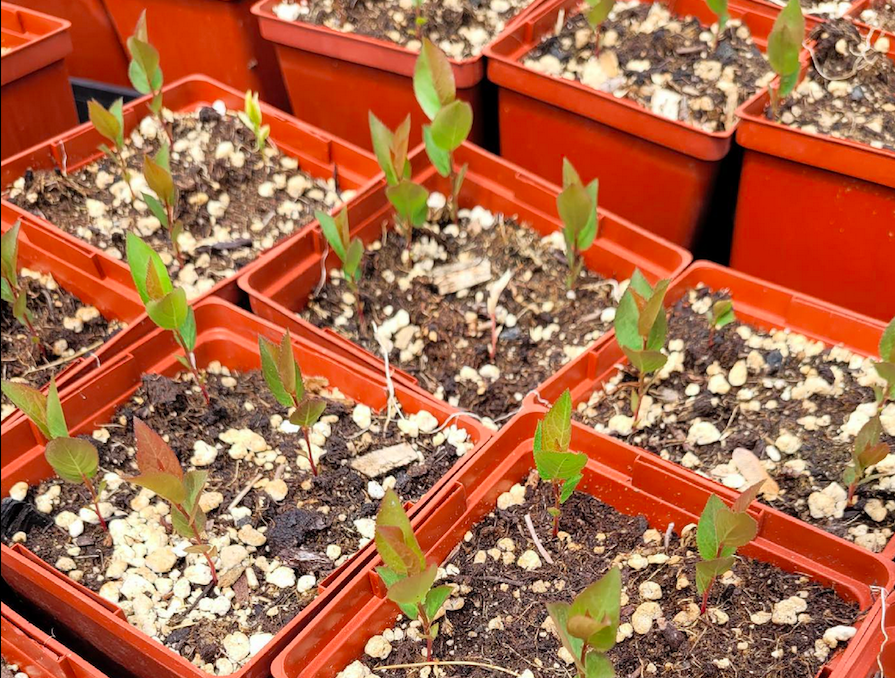
With hopes that March melts February’s freeze and April’s showers again bring May flowers, Motif’s Sean Carlson interviewed Connor Burbridge of Nuts & Bolts Nursery (374 Farnum Pike, Smithfield), a cooperative housed at the permaculture nonprofit Revive the Roots. Opened in 2021 as a worker-owned nursery specializing in edible perennial plants, Nuts & Bolts is working to build an alternative food system that combats climate change, increases biodiversity, and promotes social and economic equity. Before getting your hands dirty with yardwork this spring or wiping them clean of responsibility, review the University of Rhode Island’s searchable guide to locally native plants and the small, sustainable steps to take in your own neighborhood
Sean Carlson (Motif): It can be easy to think of “nature” as a defined place like a park or preserve, a destination within set borders. How should we consider this concept?
CB: The funny thing about nature is that it reinforces this idea that it’s separate from us, or that we’re above it. But humans have shaped the world for more than 200 thousand years. Even today, parks and forests are usually heavily managed by government agencies. Nature is the world we build around us, whether cities made of concrete and metal or neighborhoods full of trees and soil. There are complex interactions between rural areas, suburbs, and cities, with a flow of people, goods, and raw materials going back and forth between them all. We should choose and shape what nature we live in, and our co-op chooses to work towards one of biodiversity, sustainability, and equality.
SC: What would you suggest to those who’d say they aren’t gardeners or naturalists?
CB: There’s nothing wrong with starting small, experimenting, and making mistakes. Everything is a learning process. Start on a smaller scale with lower maintenance plants, like mint or basil in a planter, and get to know how to identify and use some common edible “weeds,” like dandelion or mulberry. Ask questions of other gardeners or growers and maybe check out events or workdays at a local community garden. One secret is that a lot of plants die, even for the best gardener or farmer. It’s okay if your plants don’t end up producing vegetables. It’s okay if you get too busy and your garden turns to weeds. Keep trying. Eventually, you’ll learn to be a better observer and let the plants teach you. There are many ways to grow. You will find edible and useful plants everywhere. Maybe there’s something growing in your local park that you won’t know is useful until you start gardening and paying attention to the ecosystem.
SC: For reasons of cost and convenience, many readers will turn to larger retailers for gardening supplies. How can they leave the best possible footprint?
CB: There are many incredible local nurseries and plant centers across our state, and I hope that people will give them a chance. Our nursery in Smithfield, for example, is small but we are deeply rooted in the community and support local grassroots projects. We will help people with whatever they’re dreaming up for their backyard food forests or however they’re hoping to experiment. Even if people think they don’t have a green thumb, we will be sure to get them started with the right edible plant. We want to see people growing food because it’s good for their health, their happiness, and their families. Grow food. Make art. Our belief is that we can build a regenerative culture and a caring community in the face of climate change. You won’t get all that at Home Depot.
SC: The concept of nativism is commonly associated with policies against immigration. Do you ever worry about the language of native plants and invasive species?
CB: An important thing to consider around native plants is that first we are on native land. Calls to restore historical plants to an ecosystem without addressing the issue of Indigenous people’s rights to their ancestral homelands is a deep injustice. The Indigenous people of the northeast woodlands had, and still have, incredibly complex systems for managing whole forests and rivers by understanding the connections within an ecosystem. Now, people can identify more corporate logos than they can plants, so part of the problem around invasives stems from a lack of awareness and poor ecosystem management practices. If we listened to Indigenous people, our perspectives would be different, the solutions would be more nuanced, and we would better recognize the relationship between environmental issues and social injustice.
SC: How can more mindful stewardship of the land outside our doorsteps help us all?
CB: Ultimately, everyone comes from a family and culture that at one time or another was based around farming and living in connection to the land. People might be 100 years removed from that culture but that connection is still there. Gardening and growing food can actually teach you so much about yourself and the world around you. In Farming While Black, a book reflecting on the experiences of Soul Fire Farm in Petersburg, NY, author Leah Penniman writes about the importance of connecting to your ancestral traditions through food and farming. This is important work for us white folks as well. Throughout history, many European farming peoples were kicked off their lands and forced to move into crowded cities. Part of the work to heal the wounds of white supremacy in particular is to rebuild these cultural connections to the environment and food, and address the harms done to ecosystems and cultures around the world.